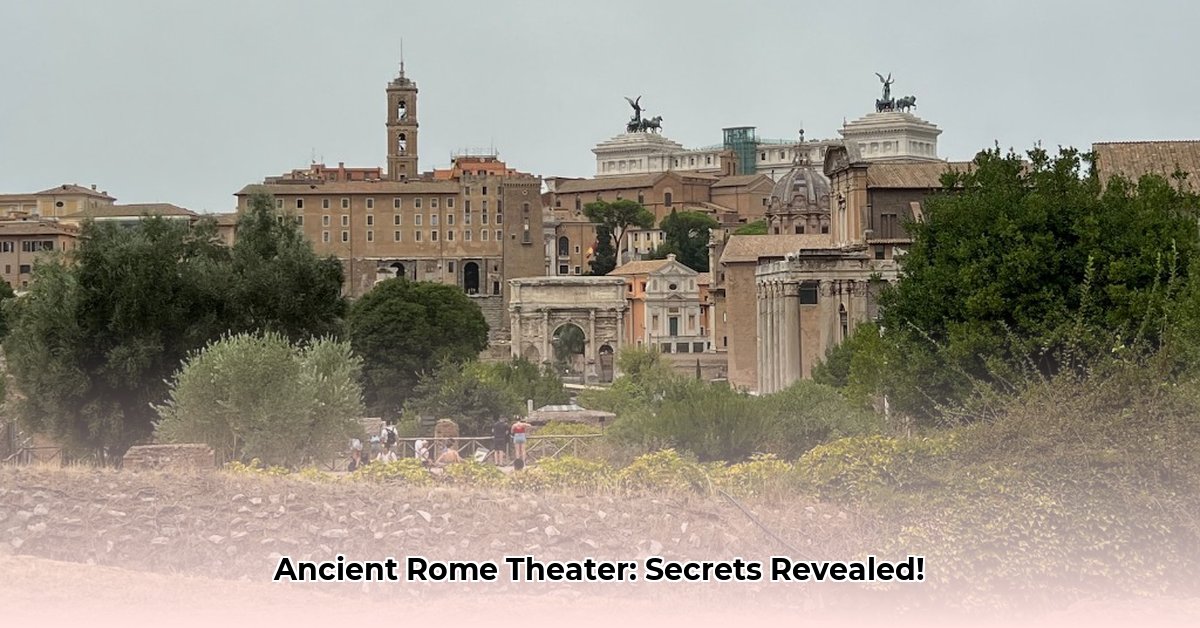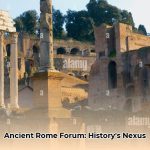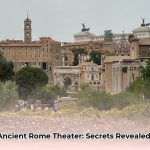The theater of ancient Rome was not merely a venue for entertainment; it stood as a monumental testament to Roman society, political power, and their unparalleled engineering genius. For further context, consider these architectural elements. Envision these structures not just as stages, but as colossal, open-air platforms broadcasting intricate messages about power dynamics, social stratification, and the very essence of Roman identity. While initially drawing heavily from Etruscan customs and Greek theatrical traditions with modest, makeshift wooden stages, these humble origins soon blossomed into something far grander, transforming into an integral component of Roman public life and imperial aspirations.
Unveiling Architectural Marvels: Roman Theaters Beyond Greek Prototypes
From Fleeting Wood to Enduring Stone: The Theatrical Revolution
What spurred the remarkable shift from temporary wooden constructions to the magnificent stone edifices we now associate with Roman theaters? A pivotal turning point arrived with the completion of Pompey’s Theatre in 55 BC. This was no ordinary performance space; it marked Rome’s first permanent stone theater, a structure that inherently symbolized the Republic’s burgeoning stature, immense wealth, and growing confidence. Prior to Pompey’s architectural marvel, theatrical events were ephemeral, tied primarily to specific religious festivals (ludi) or civic celebrations. The decision to erect a lasting theater, however, signaled a profound and permanent shift, mirroring Rome’s own expanding imperial ambitions and desire for lasting public monuments.
Deciphering the Architectural Code: Innovations and Components
The architectural blueprint of a Roman theater was far from a mere replication of Greek designs. Roman architects absorbed Greek concepts yet amplified them, infusing their distinct Roman flair and practical ingenuity. The scaenae frons stands out as a paramount example. This towering, elaborately adorned backdrop was not merely decorative; it was a uniquely Roman innovation. Imagine a colossal, intricately carved wall behind the stage, producing a visual spectacle that far surpassed anything previously witnessed in Greece. It served not only to define the scene but also to dramatically heighten the overall theatrical experience, immersing the audience in the world of the play.
Let’s dissect some of the critical components of a Roman theater, revealing their function and profound significance:
| Feature | Description | Function |
|---|---|---|
| Scaenae frons | A lavish, permanent backdrop, often several stories high, richly adorned with columns, statues, and intricate carvings, providing the main visual setting. | Served as a breathtaking visual spectacle, enhancing the theatrical experience and providing a majestic backdrop for the performance. It also functioned as a powerful canvas for imperial propaganda and the display of looted art. |
| Orchestra | A semicircular area located directly in front of the stage. | While initially used for dancing and choruses in Greek theater, in Roman contexts, it was often repurposed for seating important dignitaries, emphasizing their status and providing them with prime viewing. |
| Vomitoria | Ingeniously designed, strategically placed entrances and exits that pass through the seating area, allowing for controlled crowd movement. | Enabled large crowds to enter and exit the theater rapidly and efficiently, preventing bottlenecks and ensuring smooth transitions during intermissions and after the show. (Not for purging, despite common myth!) |
| Cavea | The tiered seating area specifically designed to accommodate thousands of spectators, typically semicircular and rising in concentric rows. | Provided extensive seating for the audience, with tiers meticulously divided by social class to reflect and reinforce the hierarchical structure of Roman society, with the elite in the lowest, most prominent seats. |
| Velarium | A massive canvas awning stretched over the theater, supported by masts and ropes, often operated by sailors. | Offered crucial shade and protection from the glaring sun and other elements, significantly enhancing the comfort of the audience and enabling performances to take place even during hot or inclement weather. |
| Pulpitum | The elevated stage where actors performed, separating them from the orchestra area. | Provided the primary performance space, elevated for better visibility. Unlike Greek theaters, the Roman stage was often quite deep and wide. |
Concrete Foundations: Building the Empire’s Theaters
The true secret weapon of Roman construction, particularly for freestanding theaters, was, unequivocally, concrete! The widespread use of opus caementicium (Roman concrete) and opus latericium (concrete faced with brick) dramatically accelerated construction timelines and resulted in structures of exceptional durability. This groundbreaking application of materials allowed them to construct monumental theaters on flat ground, unlike the Greeks who relied on natural hillsides for support. This innovation enabled the Romans to erect grand structures across their vast empire, adapting designs to diverse local conditions with remarkable efficiency. Pompey’s Theatre, for instance, measured approximately 45 meters high and could hold up to 20,000 spectators, demonstrating the scale achievable with these new techniques.
A Stage for Society: Spectacle, Propaganda, and Social Control
Roman theaters transcended their primary function as venues for plays; they were vibrant social hubs, akin to ancient community centers where people congregated to witness performances and to be observed themselves. These structures actively reinforced established social hierarchies, with senators and magistrates occupying the most prestigious front-row seats (often in the orchestra), followed by knights in the next fourteen rows, and then common citizens in the upper tiers, with women typically relegated to the very back, often among slaves.
The Roman elite were shrewd observers of human nature, deeply understanding the immense power of entertainment. Grand theatrical productions were a calculated means of exerting political influence and maintaining public contentment. Lavish spectacles, often featuring gladiatorial contests, wild animal hunts (venationes), and sophisticated stage effects, effectively diverted the public’s attention and mitigated potential unrest. This was the carefully orchestrated strategy of providing “bread and circuses” (panem et circenses) to ensure social stability. It’s quite fascinating how architecture could so intrinsically intertwine with governance, providing a platform for emperors and politicians to demonstrate their power and propagate state-approved messages. The Senate’s initial resistance to permanent theaters, lasting until 55 BC, stemmed from concerns about public morality, the potential for sedition from large gatherings, and elite competition, highlighting the perceived political risks of such popular venues.
Beyond Spectacle: Tragedy, Comedy, and Social Commentary
Roman theater was not solely a platform for extravagant spectacles; it also offered a stage for exploring profound human emotions and pressing societal dilemmas. Tragedy and comedy occupied central positions within the theatrical repertoire. Playwrights adeptly employed these genres to offer nuanced social commentary on contemporary events, often subtly criticizing those in positions of authority.
Key playwrights included:
* Livius Andronicus: A Greek captive, credited with introducing full-length, scripted plays to Rome in 240 BC by translating and adapting Greek works into Latin.
* Plautus (c. 254-184 BC): Renowned for his comedies, particularly farces (fabulae palliatae, or comedies with Greek settings), known for their witty dialogue, varied poetic meters, and stock characters like the miles gloriosus (braggart soldier) and servus callidus (clever slave). His plays often adapted Greek New Comedy.
* Terence (c. 195/185-159 BC): Also a writer of comedies (fabulae palliatae), known for his more refined language, complex plots (often combining multiple Greek originals), and exploration of human relationships and morality.
* Seneca the Younger (c. 4 BC-AD 65): A Stoic philosopher whose nine surviving tragedies (fabulae crepidatae, or Latin tragedies with Greek subjects) are characterized by a declamatory style, emphasizing rhetoric, psychological depth, and violent themes, though it’s debated if they were performed or merely read. He notably explored characters’ inner thoughts through soliloquies, distinguishing Roman tragedy from Attic Greek forms.
While playwrights cleverly found avenues to weave critiques of power into their narratives, providing audiences with thought-provoking content alongside their entertainment, a paradox existed. Actors, despite their undeniable talent and crucial role in these productions, frequently held a low social status, often equated with criminals and prostitutes. Many were slaves or freedmen, denied the same political and civic rights as ordinary Roman citizens. Unlike respected Greek actors who could achieve citizenship, Roman actors were exempt from military service, further limiting their social standing. However, notable exceptions like Quintus Roscius Gallus (125-62 BC), a famous comic actor, achieved considerable wealth and renown among the elite, even teaching acting, highlighting that individual success could sometimes transcend societal norms. Evidence also suggests that, though likely rare, women did perform speaking roles in some comedic forms, such as the mimae.
The Enduring Legacy: Echoes in Modern Design and Unresolved Mysteries
The profound influence of Roman theaters endures to this day. Modern performance venues continue to draw inspiration from their fundamental design principles. Tiered seating, the semi-circular orchestra pit (now typically for musicians), and efficient audience flow systems (like vomitoria) are all direct legacies of Roman ingenuity. Architectural masterpieces like the Theatre of Orange in France and the Colosseum (an amphitheater, but sharing some Roman design DNA) still stand as powerful reminders of this ancient legacy. Moreover, contemporary research into the composition of Roman concrete continues to yield invaluable insights into sustainable and durable building practices. It is truly remarkable that we can still benefit from the architectural wisdom of the Romans even millennia later!
While our knowledge of Roman theaters is extensive, certain questions persist. The precise nature of the early stages themselves—how realistic or grandiose they truly were—continues to invite scholarly inquiry. The ongoing scholarly exploration of these questions consistently adds depth to our comprehension of this ancient art form. Ultimately, the theater of ancient Rome offers a captivating lens through which to analyze the lives, values, and socio-political strategies of this influential ancient civilization. From its forward-thinking architectural designs to its role as a tool for social control, Roman theatrical tradition has indelibly shaped Western culture.
How Romans Built Theaters: A Masterclass in Ancient Engineering
Key Takeaways:
- Roman theaters were not just entertainment venues; they were crucial for social interaction and political messaging.
- They marked a revolutionary shift from hillside construction to freestanding, concrete-based structures, enabling placement in dense urban centers.
- The scaenae frons became a key element for propaganda and exaggerated visual spectacle.
- Entertainment evolved from traditional scripted drama to elaborate, crowd-pleasing spectacles, reflecting changing public tastes.
- Sophisticated planning ensured optimal acoustics and efficient audience management.
The Roman Theatrical Revolution: A Step-by-Step Transformation
Early Roman theatrical productions, by modern standards, operated on temporary wooden stages erected solely for specific events. Can you truly conceptualize the logistical challenge of assembling and dismantling these structures regularly? These were a stark contrast to the magnificent stone edifices we typically envision today. However, as the Roman Empire expanded, so too did its theatrical ambitions. The Romans initiated a profound transition to permanent theaters, thereby showcasing their unparalleled mastery of engineering and solidifying their cultural dominance. They were not merely mimicking the Greeks; they were fundamentally innovating, building structures that were feats of engineering in their own right.
How Romans Built Theaters: A Glimpse into the Process
The evolution and construction of Roman theaters encompassed several distinct and transformative phases:
- Site Selection and Foundation: Unlike Greek theaters carved into natural hillsides, Roman engineers often selected flat urban plots. This necessitated robust foundations, typically employing durable Roman concrete, to support the substantial weight of the entire freestanding structure. Complex vaulted substructures were a hallmark, providing support for the elevated cavea (seating area).
- Structuring the Cavea: The multi-tiered seating area was meticulously constructed, often using a combination of concrete and stone. This involved creating concentric rows of seats, ensuring optimal viewing angles while also enforcing designated social segregation. Access to these tiers was managed through the vomitoria, efficient passageways designed for rapid crowd dispersal.
- Designing the Orchestra: The semi-circular space in front of the stage evolved. While initially for performers, in the Roman era, it became a prime location for seating senators and other honored societal elites, further emphasizing social hierarchy.
- Erecting the Scaenae Frons: This was the most visually striking and uniquely Roman element. The elaborate, permanent stage backdrop was constructed, often multiple stories high, adorned with intricate architectural detailing, and incorporating statues and decorative elements. This structure housed the pulpitum (the elevated stage itself) where actors performed.
- Acoustic Engineering: Roman architects were pioneers in acoustics. The precisely engineered semi-circular layout of the cavea and the careful selection of building materials ensured that voices projected clearly and intelligibly throughout these massive venues. The scaenae frons also played a role in reflecting sound towards the audience, allowing immense audiences, often numbering in the thousands, to fully engage without artificial amplification.
- Adding the Velarium: A practical innovation for audience comfort, vast fabric awnings (the velarium) were stretched over the seating area, supported by a complex system of masts and ropes. These provided essential shade and protection from the intense Roman sun and inclement weather, allowing performances to continue comfortably.
- Propaganda and Decor: The completed structure was often lavishly decorated. The scaenae frons provided a canvas for displaying statues of gods, heroes, imperial family members, and even personifications of conquered nations, turning the theater into a powerful tool for visual propaganda and a testament to Roman dominion and military prowess.
Engineering Marvels: Beyond the Greek Prototype
The Roman theater was not merely a carbon copy of its Greek predecessor; it represented a distinct Roman reimagining, driven by societal and political forces. Here’s how these architectural forms differed fundamentally:
| Feature | Greek Theater | Roman Theater |
|---|---|---|
| Construction | Built into natural hillsides for support | Freestanding, utilizing advanced Roman concrete and complex vaulted substructures to support the cavea on level ground, allowing for urban placement and elaborate exteriors like the Theatre of Pompey. |
| Orchestra | Circular, primarily for dancing and chorus performances, part of the audience’s view. | Semicircular, often repurposed for seating important officials (senators, magistrates, Vestal Virgins), becoming a VIP section rather than a primary performance area for a chorus (which was rare in Roman plays). |
| Scaenae Frons | Simple backdrop, often temporary, painted panels, lower in height. | Elaborate, permanent, multi-story backdrop, richly ornamented with statuary, columns, and architectural details. It served as a grand visual spectacle, a permanent set, and a canvas for imperial display and propaganda. |
| Audience Access | Generally open, less controlled, often relying on natural pathways. | Highly controlled access through multiple vomitoria (efficient passageways) and a system of vaulted substructures, facilitating rapid entry and exit and allowing for the rigorous segregation of audiences based on class, gender, and social status. |
| Overall Design | Emphasized acoustics, natural setting, and the direct connection between audience and performance. | Focused on grandeur, monumental scale, and showcasing Roman engineering prowess. The fully enclosed edifice created a more intimate, yet still grand, experience, often covered with vela for comfort. |
| Curtains | Generally absent; scenes flowed seamlessly. | Roman theaters introduced curtains (aulaea), unusually raised from a slot in the stage floor to conceal it, rather than lowered from above (as in modern theaters), allowing for dramatic reveals and scene changes. |
The Scaenae Frons: More Than Just a Backdrop
The scaenae frons exemplifies a significant Roman architectural innovation. Can you envision a towering, exquisitely ornate facade serving as the permanent backdrop for every performance? It was far more than simply decorative. This monumental structure operated as a powerful instrument for projecting imperial authority and disseminating vital political messages, providing a constant visual reinforcement of Rome’s power and cultural achievements. This architectural element perfectly embodies the Roman inclination for grand spectacle and their pervasive desire to utilize every available space to reinforce their dominion.
A Stage for Society: Beyond Entertainment
Roman theaters transcended their primary function as venues for plays. They were vibrant social hubs, akin to ancient community centers where people congregated to witness performances and to be observed themselves. These structures reinforced established social hierarchies, served as conduits for political propaganda, and provided a crucial space for shared communal experiences. The performances themselves evolved over time, shifting from traditional dramatic presentations to more spectacle-driven forms of entertainment, reflecting the changing tastes and priorities of the Roman populace. This shift was particularly pronounced during the Imperial period, where audiences increasingly favored mimes (often ribald and sensational) and pantomimes (solo dancers re-enacting myths) over classical tragedies and comedies, transforming the stage into a platform for large-scale, sometimes crude, spectacles.
Regulatory Implications: Architecture as Power
In Roman theaters, architecture extended far beyond its basic purpose of functional spatial design; rather, it played an absolutely essential role in delineating the boundaries and expectations of societal and political power. Consider the carefully controlled accessibility, the rigid seating arrangements that demonstrably reflected social stratification, and the precise execution of spectacles as instruments of state messaging. Understanding and evaluating the regulatory ramifications of ancient design can offer us profound insights into the contemporary relationship between governance, shared public spaces, and societal norms. Furthermore, it highlights the enduring influence that architectural choices have on issues of fairness and the development of public discourse.
Essential Insights into The Social Status of Roman Actors: A Paradoxical Existence
Key Takeaways:
- Actors in Ancient Rome often faced significant social stigma due to associations with perceived moral issues, foreign origins, and a lack of traditional civic or military duty.
- Legal and social limitations restricted their opportunities, though instances of exceptional talent and patronage could occasionally overcome these barriers, leading to wealth and fame for some.
- Despite negative societal perceptions, theater remained an integral and highly popular aspect of Roman life and entertainment, revealing a fundamental tension in Roman society.
- The complex relationship between theatrical popularity and performer status highlights inherent tensions between public entertainment needs and established social order.
The Paradox of Popularity and Prejudice in Ancient Roman Theater
Ancient Rome was a society brimming with theatrical performances, a vibrant and ubiquitous part of daily life. Yet, those individuals who brought these stories to life occupied a curious, often unenviable, position within Roman society. How could people so central to public enjoyment and cultural expression face such widespread disdain? Essential Insights into The Social Status of Actors reveal a fascinating and enduring paradox. Actors and actresses, despite the massive crowds they attracted and the entertainment they provided, were frequently branded with significant social stigma.
The reasons for this deep-seated prejudice were multifaceted and deeply rooted in Roman societal values. Their profession was often intrinsically linked to perceptions of moral degradation, a notion fueled both by the dramatic storylines they enacted—which could be ribald or violent—and the ever-present potential for scandalous behavior off-stage. Furthermore, many performers were either enslaved individuals or foreigners (like Livius Andronicus, a Greek captive), which instantly marginalized them within the strict Roman social structure of citizens, freedmen, and slaves. Their choice to pursue an artistic career was often seen as directly conflicting with traditional Roman values emphasizing civic duty, military service, and landownership. Unlike their Greek counterparts, who could achieve respected professional status and even citizenship, Roman actors were exempt from military service, further inhibiting their rights and status. This intricate web of factors collectively contributed to their distinctly lower social standing, placing them in a category similar to criminals and prostitutes.
Legal and Social Constraints on Performers
Roman society did not merely look down upon actors; it actively sought to control and regulate them. Attempts were frequently made to restrict their activities and limit their perceived influence, reflecting underlying anxieties about the power of performance to sway public opinion and potentially incite unrest. Various laws were enacted, with varying degrees of success, attempting to restrict their movements, social interactions, and even their ability to participate fully in civic life. For instance, performers could be prohibited from testifying in court, and public beatings were not uncommon for unsatisfactory performances, particularly for enslaved actors.
However, the picture was not entirely bleak. Instances of truly exceptional talent occasionally allowed individuals to transcend these formidable barriers. A particularly gifted performer, such as Quintus Roscius Gallus, a celebrated comic actor of the late Republic, could achieve considerable wealth and widespread fame, becoming intimate with powerful figures like Sulla and Crassus. Roscius even taught acting and chose to perform without pay later in his career, offering his art as a service to the Roman people. Such individuals, while still technically beneath the social elite, garnered immense public adoration and even respect from patrons. Moreover, while male actors dominated speaking roles, later research indicates that women, such as Bassilla and Fabia Arete, performed speaking parts in popular folk comedies, and a guild existed exclusively for female stage performers (Sociae Mimae), suggesting a more nuanced reality than previously assumed regarding female participation. Yet, it is crucial to understand that these success stories remained notable exceptions, rather than the general rule. The overall landscape for actors and actresses within Roman society was one characterized by persistent social and legal constraints.
The Modern Lens: What Does It Mean Today?
Understanding the social status of Roman actors provides valuable lessons that extend far beyond the confines of ancient history. It compels us to critically examine the value we ascribe to art and entertainment, and crucially, how we perceive and treat those who create it. Are we, in contemporary society, inadvertently repeating patterns of the past, perhaps by undervaluing artistic labor or perpetuating outdated stereotypes about performers? The echoes of Roman biases still resonate in our current cultural landscape, serving as a powerful reminder to scrutinize our own attitudes toward the performing arts and the dedicated individuals who commit their lives to them. The complex relationship between the universal human need for entertainment and the societal perception of those who provide it remains a fascinating subject of historical and sociological










